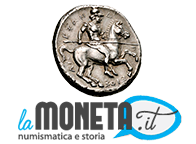Cerca nel Forum
Risultati per Tag 'Third Reich'.
Trovato 1 risultato
-
Quando l'Impero tedesco fu proclamato nel 1871 ha consistito di vari regni, granducati, ducati, principati e tre città libere, uno dei quali era Lübeck. Dopo l'unificazione, questi venticinque stati tedeschi (appena annessa Alsazia-Lorena è stata trattata non come uno stato, ma come proprietà comune degli altri) ha avuto una nuova unità di valuta—il marchio d'oro—e una monetazione che era molto come nuova Germania imperiale stessa, qualcosa di un ibrido. Monete denominate a 1-Marco e sotto erano di design uniforme e sono state emesse solo in nome della Germania imperiale, ma le monete di 2-marchi e soprattutto, oltre al loro lato comune imperiale, avevano anche disegni riflettenti del loro stato di emissione. Tre decenni e due shake-your-head, what-might-have-beens più tardi—che è, se solo Kaiser Friedrich aveva vissuto, o se solo Kaiser Wilhelm II non era stato crippled alla nascita—Germania imperiale entrò nel nuovo secolo come una potenza europea rapido aumento, ma sempre più ambiziosa. Questa cartolina del secolo fornisce che un'istantanea utile della Germania di circolazione monetazione al tempo: Tutti e tre il Kaiser tedesco sono visibili sugli alti valori diversi, ognuno dei quali è non solo tedesco, ma prussiana. (Si potrebbe anche, naturalmente, sono stati da Baviera o Sassonia, o da qualche altro stato.) E vedere soprattutto il vereinsthaler vecchio, tariffazione a 3-marchi, ancora in circolazione al momento; Questo ponte tra la vecchia monetazione degli Stati tedeschi e la nuova monetazione della Germania imperiale sarebbe rimasto sul posto fino a quando la nuova moneta da tre-marchi ha debuttato nel 1908. Ma non ogni stato nella nuova Germania imperiale aveva emesso una monetazione prima del 20° secolo... --------------------------------------------------- When the German Empire was proclaimed in 1871 it consisted of a variety of kingdoms, grand duchies, duchies ,principalities, and three free cities, one of which was Lübeck. After unification, these twenty-five German states (the newly-annexed Alsace-Lorraine was treated not as a state but as common property of the others) had a new currency unit—the gold mark—and a coinage that was a lot like the new Imperial Germany itself, something of a hybrid. Coins denominated at 1-mark and below were of uniform design and were issued in the name of Imperial Germany only, but the coins of 2-marks and above, in addition to their common Imperial side, also had designs reflective of their issuing states. Three decades and two shake-your-head, what-might-have-beens later—that is, if only Kaiser Friedrich had lived, or if only Kaiser Wilhelm II had not been crippled at birth—Imperial Germany entered the new century as a fast-rising but increasingly ambitious European power. This turn-of-the-century postcard provides a useful snapshot of Germany’s circulating coinage at the time: All three of the German Kaisers are visible on the various high values, each of which is not only German, but Prussian. (They could also, of course, have been from Bavaria, or Saxony, or from some other state.) And see especially the old vereinsthaler, tariffed at 3-marks, still in circulation at the time; this bridge between the old coinage of the German states and the new coinage of Imperial Germany would remain in place until the new three-mark coin debuted in 1908. But not every state in the new Imperial Germany had issued a coinage before the 20th century….
- 7 commenti
-
- 1
-

-
- Imperial Germany
- Kaiserreich
-
(e altri 3 tag)
Taggato come:
Lamoneta.it
La più grande comunità online di numismatica e monete. Studiosi, collezionisti e semplici appassionati si scambiano informazioni e consigli sul fantastico mondo della numismatica.
Il network
Hai bisogno di aiuto?



